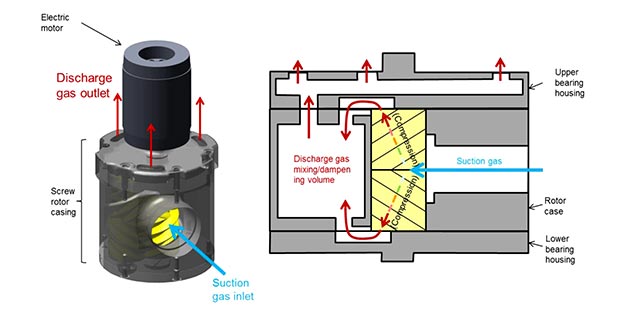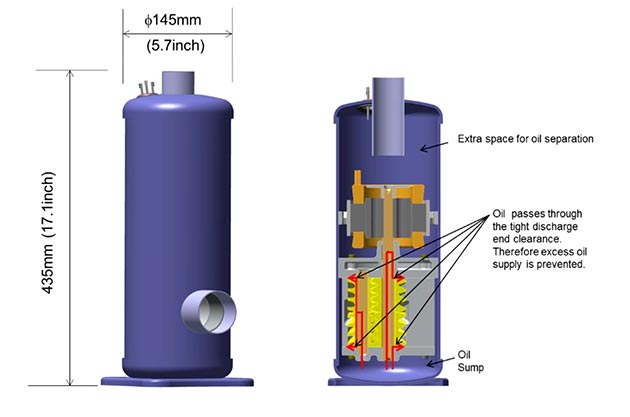Is this the future for air conditioning?
19th November 2018USA: The development of a high speed compressor working with a low pressure refrigerant could herald a low gwp, non flammable future for air conditioning.
US air conditioning manufacturer Carrier has developed a prototype high speed screw compressor and tested it with a new low pressure, non flammable HFO refrigerant as a potential long term solution for air conditioning systems.
As the world moves towards refrigerants with low GWPs, the air conditioning industry has been left largely adrift with, seemingly, no long term, non-flammable alternative for R410A in the dominant DX sector.
The refrigerant R32, along with Honeywell’s recently announced R466A, offer a lower GWP option, but their respective GWPs of around 700 make them unsustainable long term. Industry experts have estimated that under the global phase down regimes average GWPs will eventually need to be around 400.
In addition, popular thinking has previously maintained that, apart from CO2, any potential long-term low GWP refrigerant will exhibit some degree of flammability – a characteristic unsuitable under current and proposed standards and building codes for all but the smaller DX air conditioning systems.
While much of the current development work is being kept under wraps, manufacturers and refrigerant developers are known to have been working on the possibility of using low pressure HFO refrigerants with high speed compressors.
HFOs offer very low GWPs and some, like R1233zd, are non-flammable under normal operating conditions. R1233zd has already been adopted and proven by chiller manufacturers as an alternative to the use of ozone-depleting R123 in low pressure systems.
However, there are significant challenges for those seeking to deploy these refrigerants in air conditioners. Current scroll or rotary technologies may not be suitable to be applied in such low density refrigerant systems, as large increases in volumetric flows will be required in order to match the cooling capacity of R410A.
Mini screw
US manufacturer Carrier has broken cover to reveal details of what it is calling the Mini Screw. This newly-developed prototype screw compressor employs a new rotor design and a high speed permanent magnet motor to obtain a flow volume of 19.8 litres/s.
Screw compressors are well-suited for large volumetric flow, but it required a complete redesign to produce a compressor for typical R410A air conditioning applications.
Carrier says that the absence of unbalancing components such as pistons, counter weights, discharge valves, Oldham rings, vanes, etc, provides the screw compressor with a distinct advantage, particularly at high speeds.
Details of the compressor’s development and testing were presented in a paper by Carrier engineers Masao Akei, Vishnu Sishtla and Scott MacBain, entitled Mini Screw: the development of a high-CFM compact compressor for LGWP A1 low pressure refrigerant, presented at the 10th International Conference on Screw Machines in Germany in September.
The refrigerant
The choice of refrigerant for the tests is a surprise. It has previously been rumoured that tests have been carried out by unnamed manufacturers with Honeywell’s HFO 1233zd but, in this particular test, Carrier was working with a Chemours development refrigerant known as DR-12.
The Cooling Post believes DR-12 to be the HFO 1336mzz(E). Not much attention has been paid to this refrigerant, so far, but it is said to be be non-flammable and non-toxic. It is currently going through the ASHRAE classification process.
Also, 1336mzz(E) shouldn’t be confused with its “sister” refrigerant 1336mzz(Z). Although it’s basically the same molecule, it has a different arrangement of atoms, and this affects its characteristics. Both refrigerants are considered as potentials for high temperature heat pumps and organic Rankine cycle systems. R1336mzz(Z) is also already employed as a main component of R514A, a replacement for R123 in chillers.
HFO1336mzz(E) is less well known. Its critical temperature is 137.7ºC, and it has a boiling point of 7.5ºC. We also know it has a GWP of 32 (or 18 under ARP5).
Significantly, Carrier also maintains that 1336mzz(E) only requires a 7x increase in volumetric flow capacity to match R410A, compared to 10x with 1233zd.
Separate tests carried out by Chemours at 175ºC are said to have shown 1336mzz(E) to be very stable and compatible with POE oil, as well as the metals aluminium, copper and steel.
The compressor
The Carrier prototype compressor was designed for a 17.6kW capacity at 11,000rpm and 4.4kW at 2,500rpm. This was achieved in a body of similar size to current R410A compressors.
Tests were performed in accordance with ASHRAE’s compressor testing standard 23.1, and the compressor was said to have been run for more than 800 hours without any issues.
These are early days in testing this technology and, although the initial performance did not reach that of current R410A compressors, the gap was only 4-11%. Carrier’s engineers are confident that they can make it outperform the R410A compressor with further optimisation of areas such as bearings, motor, oil, gas passages, etc.
Continued development
When contacted, Chemours could not confirm or deny our story, nor would it confirm the identity of DR-12. However, speaking generally, Chemours’ Opteon global business director Joe Martinko said: “We are very encouraged by the feedback we have received from the market on DR-12, which has particularly distinctive stability and performance in a wide range of applications, including heat transfer. We look forward to continued product development and testing of this unique offering.”
Carrier’s work is ongoing and you can expect to hear more from other manufacturers combining high speed compressors with low pressure refrigerants in the future.
A copy of the research paper can be found here.
Related stories:
Secret of Honeywell’s new refrigerant – 27 June 2018
USA: Honeywell’s development of a non-flammable low GWP alternative to R410A has created huge interest, but what’s in it? The Cooling Post may have the answer. Read more…
Honeywell announces R410A breakthrough – 26 June 2018
USA: Honeywell has announced the development of a new lower GWP non-flammable alternative to R410A in stationary air conditioning systems. Read more…
Could 1336mzz(Z) be fluid for HTHPs? – August 18, 2015
USA: HFO-1336mzz(Z) is to be promoted as a potential working fluid for high temperature heat pumps at this week’s ICR 2015 conference in Japan. Read more…
Chemours to build HFO-1336mzz plant – 17 November 2015
USA: Chemours, along with its partner Changshu 3F Zhonghao, has broken ground on the world’s first full-scale production facility for HFO-1336mzz. Read more…










